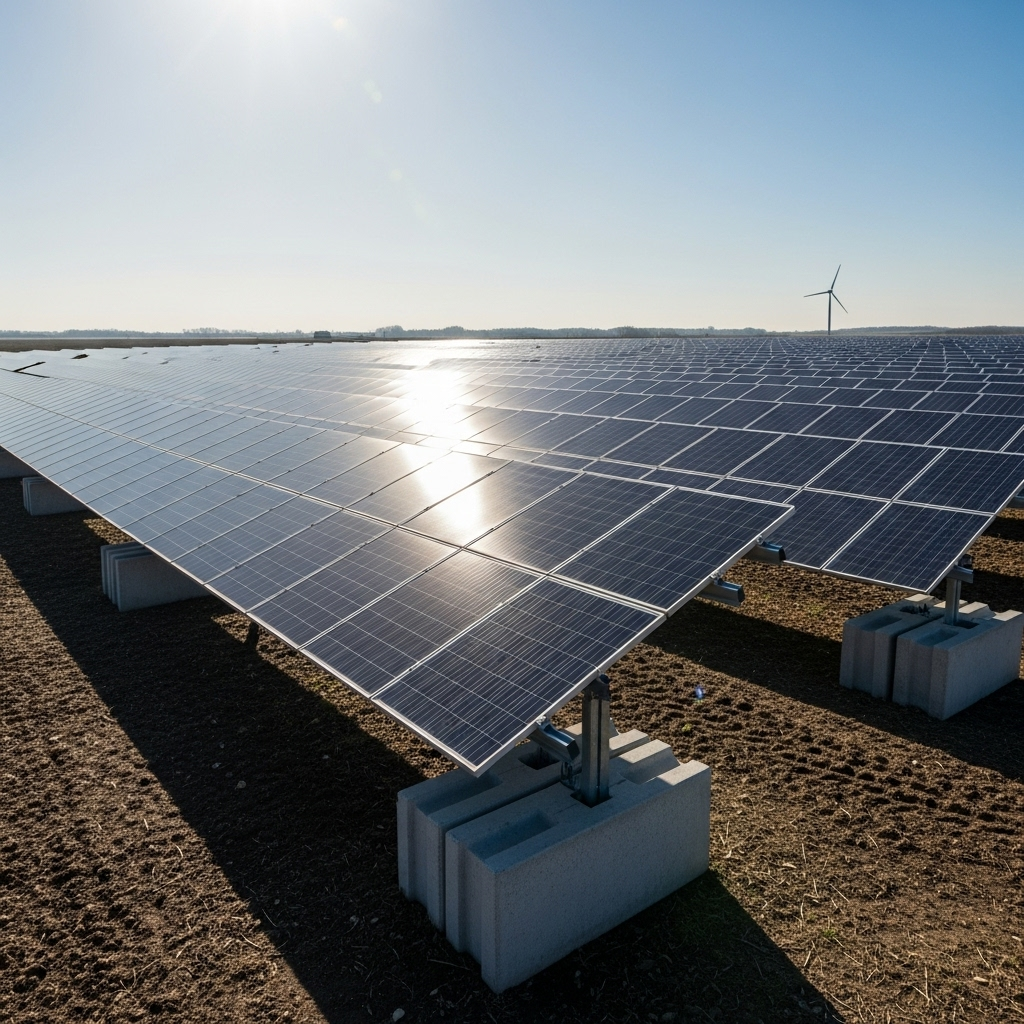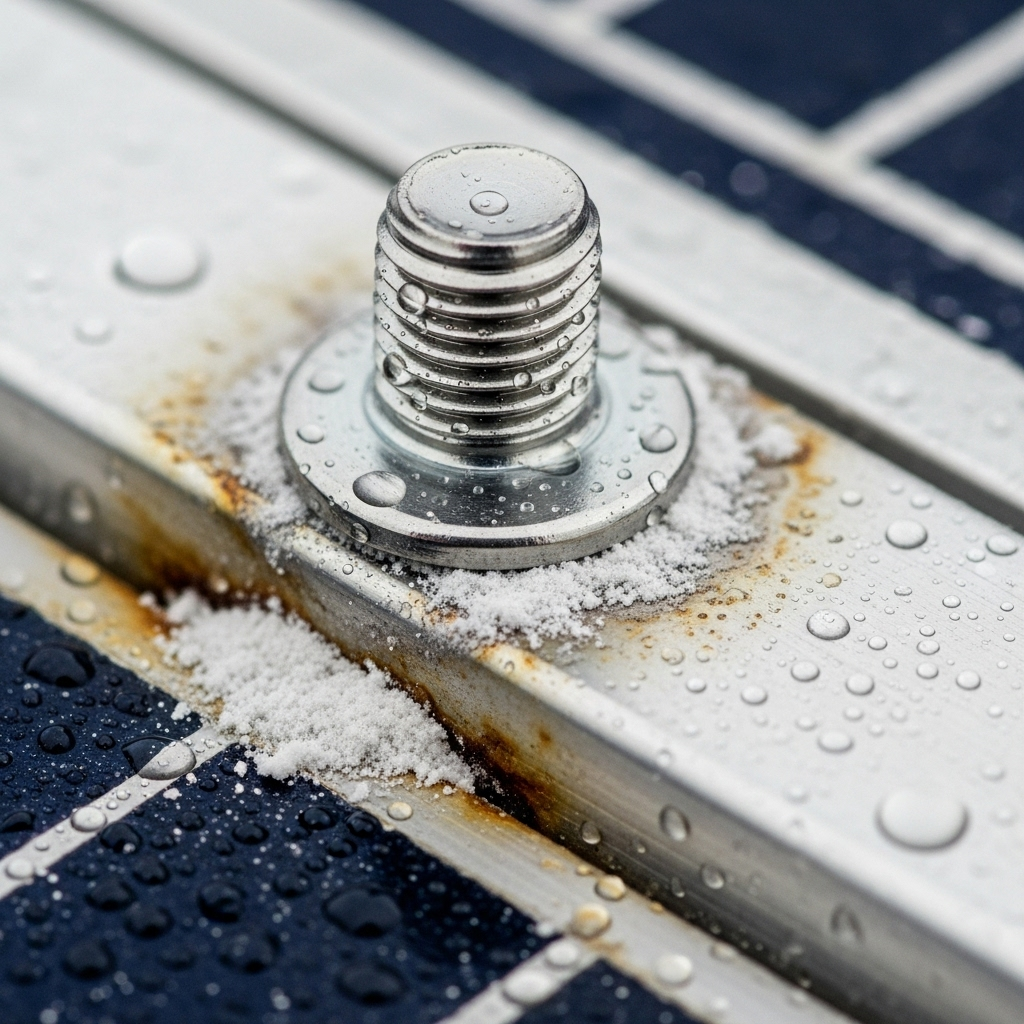Installing ground-mounted solar arrays in areas prone to high winds presents a significant engineering challenge. While traditional foundations rely on penetrating the earth, ballasted ground mounts offer a compelling alternative. They use weight to stay in place, avoiding excavation entirely. This raises a critical question: can a system held down by gravity alone truly withstand the powerful forces of high winds?
The answer is a definitive yes, but it comes with a major condition: meticulous engineering. A properly designed ballasted solar mounting system can be just as resilient as its driven-pile counterparts, even in hurricane-prone regions. This depends on a deep understanding of wind dynamics, precise calculations, and the use of specific design features.
Understanding Ballasted Ground Mount Systems
Ballasted ground mounts are a type of non-penetrating foundation for solar panels. Instead of driving posts or piles into the ground, the system is secured by placing heavy objects, typically concrete blocks, onto trays or racks integrated into the structure. This approach makes them an ideal solution for sites where ground penetration is undesirable or impossible, such as landfills, brownfields, or rooftops.
How They Achieve Stability
The core principle behind a ballasted system is simple: gravity. The weight of the ballast, combined with the weight of the array itself, creates a downward force. This force generates friction between the system and the ground surface. To remain stable, this frictional resistance must be greater than the horizontal and vertical forces exerted by the wind. The entire system is engineered to resist three primary wind-induced forces: sliding (drag), overturning (moment), and uplift.

Key Design Components
A modern ballasted system is more than just a rack with weights on it. It’s a carefully integrated structure that often includes several key components:
- Ballast Trays: These are baskets or trays designed to hold the concrete blocks or other ballast materials securely.
- Racking Structure: The metal framework that supports the solar panels at a specific tilt angle.
- Wind Deflectors: Aerodynamic shields placed on the back and sometimes sides of the array. These are critical for reducing wind uplift, which is often the most powerful force acting on the system.
Analyzing Wind Loads on Solar Arrays
To design a resilient ballasted system, engineers must first understand the forces it will face. Wind does not behave uniformly; its effects are complex and influenced by the surrounding environment. Detailed site analysis is non-negotiable. As highlighted in research from institutions like IRENA, comprehensive zoning assessments for utility-scale projects consider a multitude of local factors. This same principle of granular analysis applies to securing any ground-mount system.
Wind Speed vs. Wind Pressure
A crucial concept in structural engineering is that wind pressure increases with the square of the wind speed. This means that a seemingly small increase in wind speed results in a much larger increase in the force exerted on the solar array. For example, doubling the wind speed quadruples the pressure. This exponential relationship is why designing for a site’s maximum expected wind speed is so important.
| Wind Speed (mph) | Wind Speed (km/h) | Approximate Pressure (psf) |
|---|---|---|
| 90 | 145 | 21 |
| 110 | 177 | 31 |
| 130 | 209 | 43 |
| 150 | 241 | 58 |
Note: Pressure values are approximate and vary based on factors like air density and shape coefficients.
Site-Specific Factors
National standards, such as ASCE 7 in the United States, provide the framework for calculating wind loads. These calculations are not based on a single wind speed number. They incorporate several site-specific variables:
- Exposure Category: This classifies the terrain surrounding the site. An open field (Exposure C) experiences much higher wind forces than a sheltered urban area (Exposure B).
- Topography: Arrays built on hills or ridges will be subjected to accelerated wind speeds and require more robust designs.
- Ground Surface: The type of ground surface (e.g., gravel, pavement, grass) determines the coefficient of friction, which is a key variable in calculating the system's resistance to sliding.
Engineering Ballasted Systems for High Winds
With a thorough understanding of the potential wind loads, engineers can design a ballasted system that remains stable under extreme conditions. This involves more than just adding weight; it's about optimizing the design to manage wind forces intelligently.
The Critical Role of Wind Deflectors
Wind deflectors are arguably the most important innovation in high-wind ballasted design. By creating an aerodynamic profile, they redirect airflow smoothly over and around the array instead of allowing it to get trapped underneath. This dramatically reduces the uplift force, which in turn reduces the amount of ballast required for stability. A system with well-designed deflectors might need 30-50% less ballast than an open-back system, making it more cost-effective and reducing ground pressure.
Precise Ballast Calculation
The amount of ballast needed is not a generic value. It is calculated for each specific project using the wind loads determined from the site analysis. Engineers use a safety factor, typically 1.5 or higher, to ensure the system's resistive forces (gravity and friction) are significantly greater than the active wind forces (uplift and drag). This calculation ensures the system will not slide or lift off the ground during a design-level wind event.
Performance, Limitations, and System Reliability
When properly engineered, ballasted ground mounts have a proven track record of performance in high-wind zones. They have successfully weathered hurricanes and other severe weather events. However, their success is entirely dependent on the quality of the initial design and the components used. A robust mounting system protects the power-generating assets, but the overall energy independence relies on the entire system's quality. As explained in the Ultimate Reference for Solar Storage Performance, pairing a secure array with high-performance batteries and inverters ensures that the energy generated is reliably stored and available when needed, which is especially critical in areas susceptible to grid outages from extreme weather.
When to Consider Alternatives
Ballasted systems are not the solution for every site. There are situations where a penetrative foundation like a driven pile or helical screw is a better choice:
- Very Poor Soil Conditions: On sites with a very low coefficient of friction, such as those with loose sand or wet clay, the amount of ballast required might become impractical or prohibitively expensive.
- Steep Slopes: While some ballasted systems can accommodate moderate slopes, steep grades can complicate installation and stability, making driven piles a more secure option.
- Extreme Wind Speeds: In locations with the highest design wind speeds (e.g., Category 5 hurricane zones), a hybrid approach or a fully penetrative foundation may provide a greater margin of safety.
Final Thoughts on System Stability
Ballasted ground mounts are a viable and effective solution for solar installations in many high-wind zones. Their non-penetrating nature offers unique advantages for a variety of challenging sites. Their success, however, is not automatic. It is the direct result of rigorous, site-specific engineering that accurately accounts for wind loads and incorporates design features like wind deflectors to manage those forces. By prioritizing a quality design and robust components, you can deploy a ballasted system with confidence, knowing it is built to last.
Disclaimer: This article provides general information and is not a substitute for professional engineering advice. Always consult with a qualified structural engineer to design a solar mounting system that complies with local building codes and is appropriate for your specific site conditions.
Frequently Asked Questions
How much wind can a ballasted solar mount handle?
This is entirely dependent on the engineering design. A system can be engineered to withstand winds of 150 mph (241 km/h) or more, but this requires a site-specific analysis, a significant amount of ballast, and optimized aerodynamic features like wind deflectors.
Is a ballasted system more expensive than a driven pile system?
It depends on the site. The material cost for concrete ballast blocks can be higher than for steel piles. However, ballasted systems save costs on geotechnical reports, heavy pile-driving machinery, and specialized labor. On sites where excavation is difficult or prohibited, a ballasted system is often the most cost-effective solution overall.
What happens if the ballast calculation is wrong?
An incorrect ballast calculation can lead to catastrophic failure. Under-engineering the system by not using enough weight can cause the array to slide or be lifted by the wind, resulting in complete destruction of the solar panels and racking. This poses a significant safety risk and financial loss. It is essential to have the design certified by a professional engineer.





Leave a comment
All comments are moderated before being published.
This site is protected by hCaptcha and the hCaptcha Privacy Policy and Terms of Service apply.